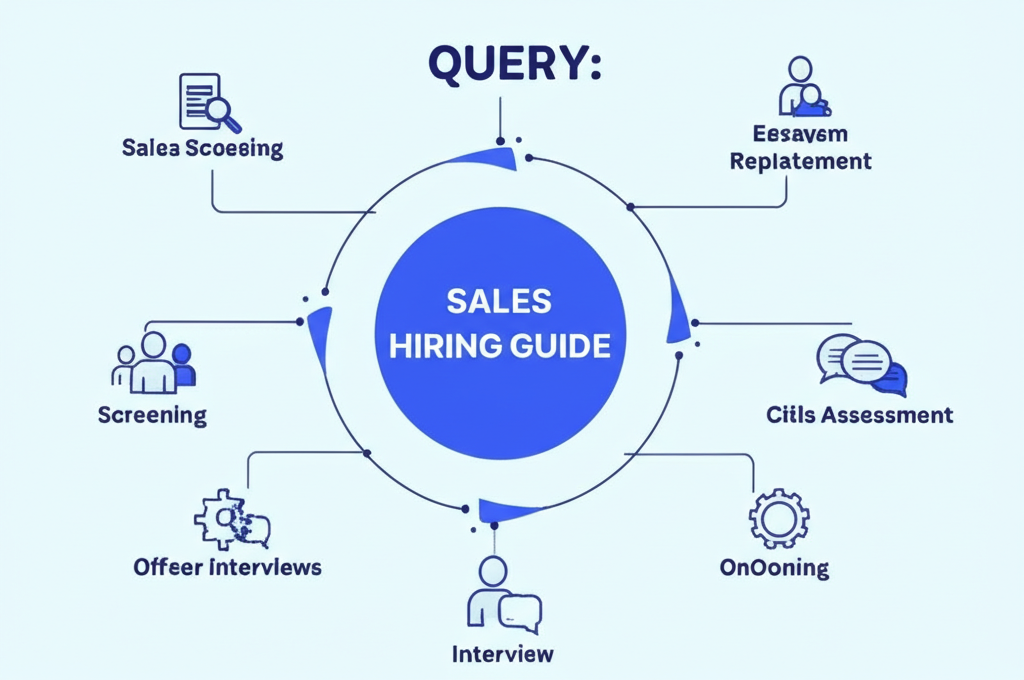The Complete Guide to SDR Hiring in 2025

Introduction
Hiring the right Sales Development Representatives (SDRs) is critical to building a successful sales organization. These frontline sales professionals are often responsible for the crucial first impression your company makes on potential customers. Yet, many organizations struggle with high SDR turnover rates and inconsistent performance.
This comprehensive guide will walk you through every aspect of the SDR hiring process, from defining the role and sourcing candidates to conducting effective interviews and creating a successful onboarding program.
Defining the SDR Role
Before you start hiring, it's essential to clearly define what you're looking for in an SDR. This includes:
Key Responsibilities
- Prospecting and outreach to potential customers
- Qualifying leads through phone, email, and social selling
- Setting appointments for Account Executives
- Managing and updating CRM data
- Researching prospects and companies
- Collaborating with marketing on lead generation
Essential Skills and Attributes
- Strong communication skills (both written and verbal)
- Resilience and ability to handle rejection
- Curiosity and quick learning ability
- Time management and organizational skills
- Basic technical aptitude
- Coachability and growth mindset
- Problem-solving abilities
Creating an Effective Job Description
Your job description is often the first interaction candidates have with your company. It should:
- Clearly outline responsibilities and expectations
- Highlight growth opportunities and career paths
- Specify required and preferred qualifications
- Communicate your company culture and values
- Include compensation information when possible
Pro Tip
Avoid using too many requirements that might discourage qualified candidates. Research shows that women are less likely to apply for jobs unless they meet 100% of the criteria, while men will apply when they meet about 60%.
Be specific about what success looks like in the role. Instead of vague statements like "must be a good communicator," use concrete examples such as "ability to clearly explain our value proposition to prospects in a 30-second call."
Sourcing SDR Candidates
Finding quality SDR candidates requires a multi-channel approach:
Job Boards
Post on specialized sales job boards like SalesJobs, SalesGravy, and general platforms like LinkedIn and Indeed
University Recruiting
Partner with college career centers and attend career fairs to find motivated recent graduates
Employee Referrals
Create incentive programs for your team to refer qualified candidates from their networks
Social Media
Leverage LinkedIn, Twitter, and other platforms to share job postings and engage with potential candidates
Non-Traditional Candidate Sources
Some of the best SDRs come from backgrounds outside of traditional sales:
- Hospitality industry: Restaurant servers and hotel staff often have excellent customer service skills
- Retail: Retail associates understand customer needs and have experience handling objections
- Customer service: Support representatives know how to manage difficult conversations
- Education: Teachers and coaches excel at explaining complex concepts and motivating others
The SDR Interview Process
A structured interview process helps ensure you're evaluating all candidates consistently:
1. Initial Screening
Start with a 15-30 minute phone screen to assess basic qualifications and communication skills:
- Brief overview of the candidate's background and experience
- Assessment of communication style and phone presence
- Questions about motivation and interest in sales
- Basic scenario questions to gauge problem-solving abilities
2. Skills Assessment
Implement practical assessments to evaluate key SDR skills:
- Written communication: Email writing exercise responding to a prospect
- Research abilities: Company research task with limited time
- Objection handling: Written or verbal responses to common objections
- CRM aptitude: Basic CRM navigation or data entry task
3. In-Depth Interviews
Conduct comprehensive interviews with key stakeholders:
- Hiring manager interview: Focus on experience, skills, and cultural fit
- Team interview: Meeting with potential peers to assess team dynamics
- Sales leadership interview: Discussion with sales leadership about career goals and potential
4. Roleplay Exercise
The most critical part of the SDR interview process is a structured roleplay:
Effective Roleplay Structure
- Provide the candidate with basic information about your product/service
- Give them 15-20 minutes to prepare
- Conduct a 5-10 minute cold call roleplay
- Provide feedback and direction
- Conduct a second roleplay to assess coachability
This exercise reveals not only the candidate's current abilities but also their potential for growth and how they respond to coaching – critical factors for SDR success.
Evaluating SDR Candidates
Use a consistent scoring system to evaluate candidates across multiple dimensions:
| Dimension | What to Look For | Weight |
|---|---|---|
| Communication Skills | Clarity, conciseness, ability to explain concepts, active listening | 25% |
| Resilience | Response to rejection, persistence, positive attitude | 20% |
| Coachability | Implementation of feedback, adaptability, willingness to learn | 20% |
| Problem-Solving | Critical thinking, creativity, ability to overcome obstacles | 15% |
| Technical Aptitude | Comfort with technology, ability to learn new tools | 10% |
| Cultural Fit | Alignment with company values, teamwork, collaboration | 10% |
Have all interviewers use the same evaluation form and scoring system to ensure consistency. Meet as a hiring team to discuss candidates and make decisions based on objective criteria rather than gut feelings.
Making the Offer
Once you've identified your top candidate, move quickly to make a competitive offer:
- Compensation structure: Clearly outline base salary, commission/bonus structure, and OTE
- Benefits package: Highlight healthcare, retirement, and other benefits
- Growth opportunities: Discuss career progression paths and timelines
- Start date and onboarding: Set clear expectations for the first few weeks
Pro Tip
The best candidates often have multiple offers. Consider adding personalized touches to your offer process, such as a call from the CEO or a welcome package, to demonstrate your enthusiasm for the candidate.
SDR Onboarding Best Practices
A structured onboarding program is crucial for SDR success:
Week 1: Orientation and Foundation
- Company history, mission, values, and culture
- Product/service knowledge fundamentals
- Introduction to team members and key stakeholders
- Basic systems training (email, CRM, etc.)
- Shadow experienced SDRs on calls
Weeks 2-3: Skills Development
- In-depth product training
- Ideal customer profile and buyer persona education
- Prospecting techniques and best practices
- Call scripts and email templates
- Objection handling training
- CRM and sales tool mastery
Week 4: Guided Practice
- Roleplay exercises with managers and peers
- Supervised prospecting activities
- Call reviews and feedback sessions
- Gradual increase in activity expectations
Ongoing Support
- Regular 1:1 coaching sessions
- Call reviews and feedback
- Continued product and industry training
- Peer mentorship program
- Clear performance expectations and milestones
Measuring SDR Hiring Success
Track these metrics to evaluate the effectiveness of your SDR hiring process:
Time to Productivity
How quickly new SDRs reach target performance levels
Retention Rate
Percentage of SDRs who remain with the company after 6, 12, and 18 months
Performance Distribution
Spread of performance metrics across new hires
Hiring Manager Satisfaction
Feedback from managers on the quality of new hires
Regularly review these metrics and refine your hiring process based on the data. The most successful organizations continuously improve their approach to SDR hiring based on outcomes.
Conclusion
Hiring great SDRs is both an art and a science. By implementing a structured process that includes:
- Clear role definition and compelling job descriptions
- Multi-channel sourcing strategies
- Comprehensive interview processes with practical assessments
- Objective evaluation criteria
- Competitive offers
- Structured onboarding programs
You can significantly improve the quality and retention of your SDR team, leading to better sales results and a stronger pipeline of future sales leaders for your organization.
Transform Your SDR Hiring Process
FirstDial helps sales leaders implement data-driven hiring processes that reduce turnover and improve team performance. Our AI-powered platform provides objective candidate assessments and predictive insights.
Request a Demo

